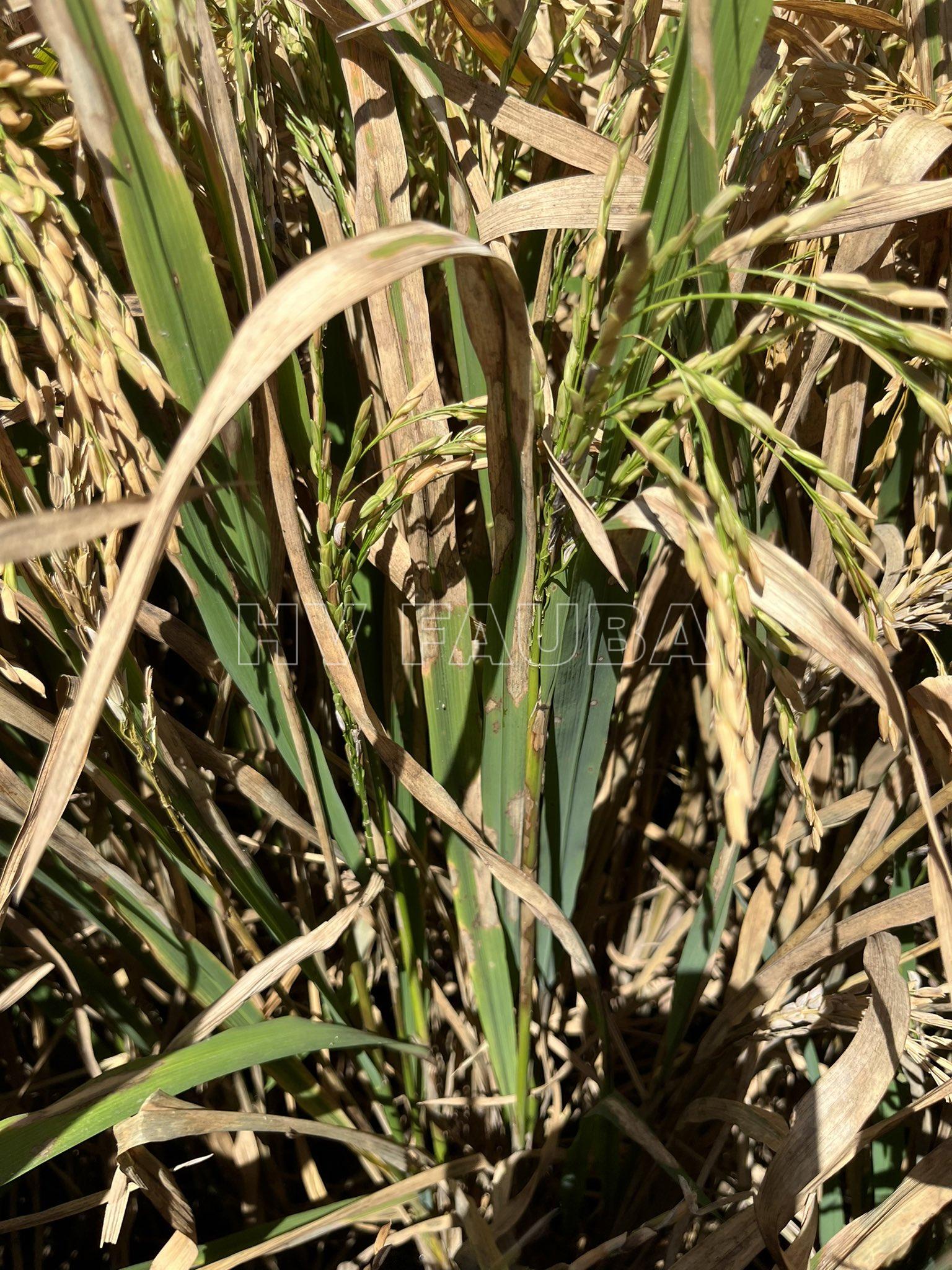.
Condición fitosanitaria: Presente
Grupo de cultivos: Cereales
Especie hospedante: Arroz (Oryza sativa)
Rango de hospedantes: R. solani tiene un amplio rango de hospedantes. Entre los cultivos susceptibles se encuentran el maní, el algodón, y el tabaco entre otros.
Etiología: Hongo. Necrotrófico
Agente causal:
Rhizoctonia solani Kuhn (teleomorfo Thanatephorus cucumeris) [Tizón de la vaina]
R. oryzae Ryker & Gooch, 1938 (teleomorfo Waitea circinata Warcup & P.H.B. Talbot, 1962 Warcup & P. H. B. Talbot, 1962) [Mancha de la vaina]
R. oryzae-sativae (teleomorfo Ceratorhiza oryzae-sativae), basionym: Sclerotium oryzae-sativae Sawada, 1919, syn Ceratobasidium oryzae-sativae [Mancha agregada de la vaina]
.
Taxonomía: Eukaryota > Fungi > Dikarya > Basidiomycota > Agaricomycotina > Agaricomycetes > Agaricomycetes incertae sedis > Cantharellales > Ceratobasidiaceae > Rhizoctonia
.
.
Antecedentes
En el cultivo de arroz, las enfermedades de la vaina causadas por el “complejo Rhizoctonia”, causan importantes pérdidas económicas en todas las regiones del mundo productoras de este cereal. El Tizón de la Vaina (TV), causado por R. solani AG1-1A, es la segunda enfermedad fúngica de mayor importancia del arroz después del Tizón del Arroz, causado por Pyricularia oryzae, tanto en climas tropicales como templados.
Las pérdidas de rendimiento causadas por el “complejo Rhizoctonia” pueden llegar al 50% en variedades de arroz muy susceptibles susceptibles, cuando las condiciones ambientales son favorables para el desarrollo de la enfermedad y existe una densidad de inóculo inicial elevado en los lotes de arroz.
.
Síntomas
- Autor: Tom Allen
- Autor: Tom Allen
- Autor: Tom Allen
.
Manejo de la enfermedad
Es un hongo habitante normal del suelo, polífago, por lo tanto de muy difícil control. En el suelo se encuentra como micelio activo o como esclerocios. El manejo de la enfermedad se basa en implementar un esquema de rotaciones que favorezca el desarrollo de la flora antagonista del suelo.
.
.
Bibliografía
Acharya U, Das T, Ghosh Z, Ghosh A (2022) Defense Surveillance System at the Interface: Response of Rice Towards Rhizoctonia solani During Sheath Blight Infection. Mol Plant Microbe Interact. 35(12): 1081-1095. doi: 10.1094/MPMI-07-22-0153-R
Das A, Mazahar M, Sahu A, et al. (2021) Differential Regulation of Rice Transcriptome to Rhizoctonia solani infection. bioRxiv 2021.05.05.442799; doi: 10.1101/2021.05.05.442799
Feng S, Shu C, Wang C, et al. (2017) Survival of Rhizoctonia solani AG-1 IA, the Causal Agent of Rice Sheath Blight, under Different Environmental Conditions. J Phytopathol. 165: 44-52. doi: 10.1111/jph.12535
Kagale S, Marimuthu T, Kagale J, et al. (2011) Induction of systemic resistance in rice by leaf extracts of Zizyphus jujuba and Ipomoea carnea against Rhizoctonia solani. Plant Signal Behav. 6(7): 919-23. doi: 10.4161/psb.6.7.15304
Lee DY, Jeon J, Kim KT, et al. (2021) Comparative genome analyses of four rice-infecting Rhizoctonia solani isolates reveal extensive enrichment of homogalacturonan modification genes. BMC Genomics 22: 242. doi: 10.1186/s12864-021-07549-7
Li D, Li S, Wei S, et al. (2021) Strategies to Manage Rice Sheath Blight: Lessons from Interactions between Rice and Rhizoctonia solani. Rice 14: 21. doi: 10.1186/s12284-021-00466-z
Lin Y-H, Shen S-M, Wen C-J, et al. (2021) Molecular Detection Assays for Rapid Field-Detection of Rice Sheath Blight. Front. Plant Sci. 11: 552916. doi: 10.3389/fpls.2020.552916
Maeda S, Dubouzet JG, Kondou Y, et al. (2019) The rice CYP78A gene BSR2 confers resistance to Rhizoctonia solani and affects seed size and growth in Arabidopsis and rice. Sci Rep 9: 587. doi: 10.1038/s41598-018-37365-1
Oh Y, Lee S, Rioux R, et al. (2022) Analysis of Differentially Expressed Rice Genes Reveals the ATP-Binding Cassette Transporters as Candidate Genes Against the Sheath Blight Pathogen, Rhizoctonia solani. PhytoFrontiers™ 2: 105-115. doi: 10.1094/PHYTOFR-05-21-0035-R
Srinivasachary, Willocquet L, Savary S (2011) Resistance to rice sheath blight (Rhizoctonia solani Kühn) [(teleomorph: Thanatephorus cucumeris (A.B. Frank) Donk.] disease: current status and perspectives. Euphytica 178: 1–22. doi: 10.1007/s10681-010-0296-7
Uppala S, Zhou XG (2018) Rice Sheath Blight. The Plant Health Instructor. doi: 10.1094/PHI-I-2018-0403-01
Wang H, Meng J, Peng X, et al. (2015) Rice WRKY4 acts as a transcriptional activator mediating defense responses toward Rhizoctonia solani, the causing agent of rice sheath blight. Plant Mol Biol. 89(1-2): 157-71. doi: 10.1007/s11103-015-0360-8
, , , et al. (2023) Knockout of transcription factor OsERF65 enhances ROS scavenging ability and confers resistance to rice sheath blight. Molecular Plant Pathology 24: 1535–1551. doi: 10.1111/mpp.13391
, , , et al. (2023) p-aminobenzoic acid and vitamin B9 enhance rice defence against sheath blight disease caused by Rhizoctonia solani. Plant Pathology 00: 1–14. doi: 10.1111/ppa.13804
Zhang CQ, Liu YH, Ma XY, et al. (2009) Characterization of sensitivity of Rhizoctonia solani, causing rice sheath blight, to mepronil and boscalid. Crop Protection 28: 381-386. doi: 10.1016/j.cropro.2008.12.004


